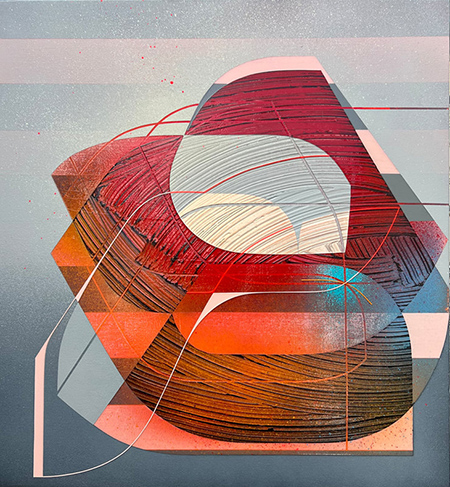
Continuing through July 21, 2023
“Atmospheric” pairs the works of photographer Cara Barer and painter Alex Couwenberg. The title suggests both meteorology and, to the art-historically-minded, atmospheric perspective, that softening of contour and contrast toward the bluish horizon seen in landscape paintings. Barer’s ‘portraits’ of bound hardback books transform their soaked, dyed pages into suggestions of the floral realm. Couwenberg’s abstractions, melding painterly gesture with airtight composition, may not literally fit either of those definitions of “Atmospheric,” but the title does suggest visual aura, the aesthetic magic that draws, retains, and rewards our gaze. Couwenberg’s objects radiate force fields of pulsing meaning and mystery.
Barer dates her book-based conceptual photography to a humorous epiphany — “a random encounter with a Houston Yellow Pages” in the transitional period between analog and digital cultures, when reference books were being transformed into online information and the books themselves were being discarded. Clearly, the artist, with her fondness for the print medium (and for printed roadmaps over their GPS replacements), saw this transition as worthy of investigation.
Barer describes her work, collecting old books and, deconstructing and reconstructing them, as a kind of recycling of obsolete data, repurposing the now useless objects as art — and as a commemoration of books as physical objects with their own life and life cycle. “I create a record of that book and its half-life,” she notes. Her orphaned hardcover books, unbound and rebound, dyed and dried into splayed, circular arrays of rippling, radiating pages, become botanical metaphors for sentience, spores or seed pods ready to transmit their coded/printed but unseen and undecipherable information. Barer’s floral books with their pages viewed edge-on are also mandalas, aids to meditation, or iconic symbols, like Dante’s mystic rose, or Jay DeFeo’s famously ethereal yet ponderous Beat-Era painting “The Rose.”
Six of the seven photos here — “Air,” “Fire,” “Water,” “Aether, and “Green Earth, New Sky” — are circular blooms set against square backdrops suggestive of wind and water. The elemental themes and organic motifs are matched with the geometry of perfect forms. The seventh, “Cotton Candy Landscape,” depicts a verdant landscape bouquet of pages set against fluffy clouds, but the foliage also suggests flame; whether this presages intellectual enlightenment, or a 451-degree bonfire of vanities remains to be seen.
In his essay on the Great Wall and the burning of the books by the self-styled First Emperor of China, Jorge Luis Borges famously declared that the aesthetic phenomenon is the dreamlike state of sensing an imminent but elusive revelation. Couwenberg’s abstract acrylic paintings display beauty and visual authority, yet their spatial relationships remain ambiguous and shifting, i.e. infinite. While the flat colors and crisp edges of the artist’s geometric structures suggest digital origins (what I call Adobe Illustrator painting), the free brushwork, spattering, and acrylic impasto textures evince an impressive command of paint handling and the complex grammar of color, shape, and form.
Says Couwenberg, “My paintings are a product of my obsession over process … Each painting becomes an experience of constantly juxtaposing elements and forms within a composition attempting to arrive at a relationship between balance, tension, and harmony.”
This dialectic is based on the artist’s Southern California cultural influences, including the historical adaptation of car culture, informed by Finish Fetish and Light and Space art. Creating sharply delineated form teams with Couwenberg’s opposing tendency, breaking out of the Constructivist box with Expressionist brushwork and texture resulting in visual richness and spatial ambiguity. The impeccable finish of the lines, curves and planes create a perfect, even utopian miniature world that seems in places, to be emerging into the viewer’s space thanks to relief effects probably achieved with layers of acrylic gel applied within taped or stenciled areas. Couwenberg’s take on Abstract Illusionism — impasto blots or brushstrokes embellished with airbrushed shadows — goes beyond just fooling the eye. As Duchamp said of his own ‘lighthearted’ conceptualism, it fools the mind.
Couwenberg’s playful titles, such as “Dear You…,” “Adrift, Stinger,” and “The Imperial,” hint at private jokes, and a witty but disciplined sensibility informing the discipline of the artist’s hand. Two pieces, “Kon-Tiki” and “Hōkūleʻa,” are named after Thor Heyerdahl’s balsa wood raft, which sailed from South America to Polynesia in 1947, and the contemporary analogue that has circumnavigated the globe using traditional (orally transmitted) wayfinding techniques. Perhaps these canvases, each a contraption of wood and cloth, are vessels for adventuring: “to strive, to seek, to find, and not to yield,” as Alfred, Lord Tennyson maintained in his poem, “Ulysses.” Unlike Tennyson’s version of Ulysses contemplating the boredom of old age in light of his earlier adventures, Couwenberg’s aesthetic adventure persists.
